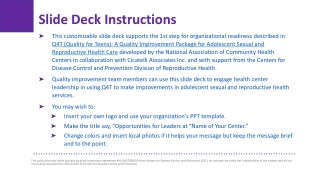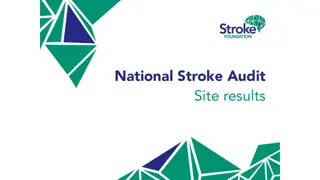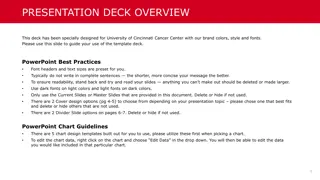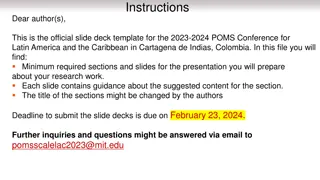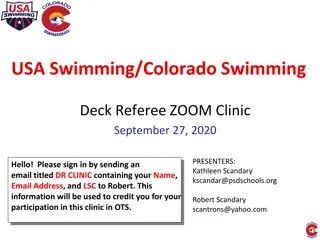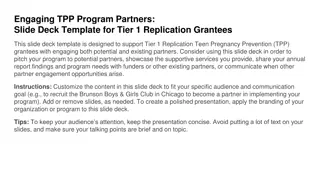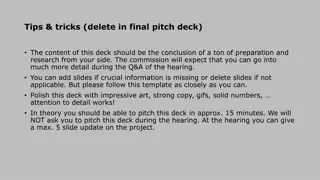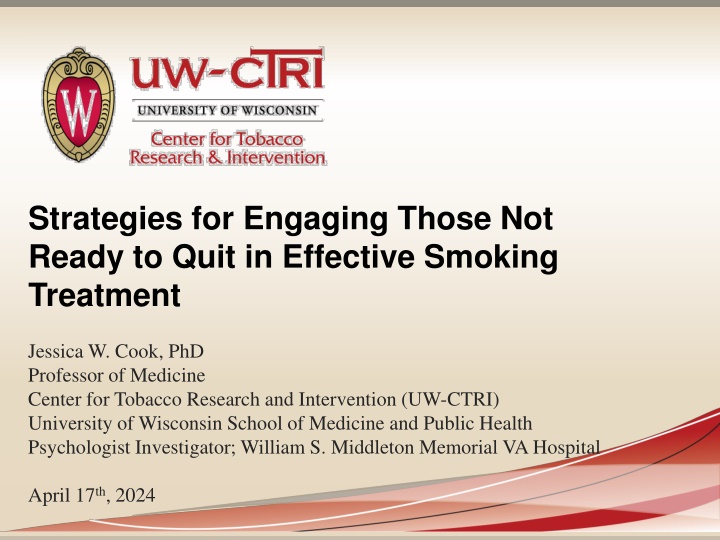
Engaging Strategies for Effective Smoking Treatment
Discover effective strategies for engaging individuals not yet ready to quit smoking in comprehensive treatment programs to reduce smoking-related mortality rates. Learn about the challenges, prevalence data, projections, and ways to improve smoking treatment in healthcare systems.
Download Presentation

Please find below an Image/Link to download the presentation.
The content on the website is provided AS IS for your information and personal use only. It may not be sold, licensed, or shared on other websites without obtaining consent from the author. If you encounter any issues during the download, it is possible that the publisher has removed the file from their server.
You are allowed to download the files provided on this website for personal or commercial use, subject to the condition that they are used lawfully. All files are the property of their respective owners.
The content on the website is provided AS IS for your information and personal use only. It may not be sold, licensed, or shared on other websites without obtaining consent from the author.
E N D
Presentation Transcript
Strategies for Engaging Those Not Ready to Quit in Effective Smoking Treatment Jessica W. Cook, PhD Professor of Medicine Center for Tobacco Research and Intervention (UW-CTRI) University of Wisconsin School of Medicine and Public Health Psychologist Investigator; William S. Middleton Memorial VA Hospital April 17th, 2024
Smoking and Mortality Leading preventable cause of death and disease in the US 1 in 5 deaths 500,000 deaths/year Smoking results in 10-20 years of lost life
The Challenge What can we do to reduce and ultimately eliminate smoking so that current and future generations do not continue to die from smoking-related deaths?
Smoking Prevalence Among U.S. Adults, 1955-2023 45 40 2023 = 11.8% 35 30 Percent 25 20 15 10 5 0 Year Source: NHIS/CDC
Projections Based on Recent Trends 45 40 35 30 Percent 25 20 15 10 5 0 Year
What will it take to accelerate progress? 45 40 35 30 Percent 25 20 15 10 5 0 Year
Improve Smoking Treatment Offered in Healthcare Systems 80% of people who smoke visit a primary care physician each year The healthcare system is an important venue for treating smoking
Smoking Treatment in Primary Care Only ~ 5% of patients leave their healthcare visit with recommended evidence-based treatment for their smoking (both counseling and medication) Source: MMWR 2017
Obstacles to Providing Effective Tobacco Treatment in Healthcare Systems Not enough patients who smoke enter evidence-based smoking treatment Those who do start treatment tend to disengage from it before they achieve abstinence.
Objective: Enhance flow of patient-driven change in tobacco use Abstinence Stage 1 Start treatment Stage 2 Sustain Engagement Patient desire to change their tobacco use Better health
Stage 1: Barriers to Starting Treatment Patients not ready to quit typically aren t offered smoking treatment Most treatment offered targets cessation from smoking 70-90% are not ready to quit at any given clinic visit This restricts the population of patients who can be treated for their tobacco use
Objective: Enhance flow of patient-driven change in tobacco use and health Abstinence Stage 1 Start treatment Stage 2 Sustain Engagement Patient desire to change their tobacco use Offer Tx for those not ready to quit Better health
PHS Guidelines Limited data on treating those not ready to to quit when 2008 Guidelines were published The Guidelines recommended NRT and MI for people not ready to make a quit attempt
Reduction Treatment Typically involves NRT + counseling Goals is to make incremental changes to smoking that lead to quit attempts and abstinence Using NRT to replace cigarettes Decreasing smoking heaviness Increasing time between cigarettes Reducing exposure to environmental smoking cues
What Recent Research Tells Us About Offering Reduction Treatment to People Not Ready to Quit 4 Key Take Aways:
1. Reduction treatment increases the reach of tobacco treatment when it is offered in addition to cessation treatment in healthcare settings About 25% more patients enter smoking treatment when reduction treatment is offered in addition to cessation treatment during primary care visits (Cook et al., 2021; Cook et al., 2016). 16
2. NRT increases quit attempts and abstinence in those initially not ready to quit The Cochrane Collaboration (Stead et al., 2008)and Moore et al. (2009) meta-analyzed multiple placebo- controlled tests of NRT and found that NRT produced greater smoking reduction and higher abstinence than placebo Short-activing NRT (gum, mini-lozenge) appears to be especially effective (Cook et al., 2016; 2021) 17
3. The side effects of using NRT while smoking are minimal and are considered an acceptable risk compared to smoking Moore D, Aveyard P, Connock M, Wang D, Fry-Smith A, Barton P. Effectiveness and safety of nicotine replacement therapy assisted reduction to stop smoking: systematic review and meta-analysis. BMJ. 2009;338:b1024 Food and Drug Administration (2013b). Nicotine replacement therapy labels may change. FDA Consumer Health Information. Silver Spring, MD: U.S. Department of Health and Human Services Cook JW, Baker TB, Fiore MC, Collins LM, Piper ME, Schlam TR, Bolt DM, Smith SS, Zwaga D, Jorenby DE, Mermelstein R. Evaluating four motivation-phase intervention components for use with primary care patients unwilling to quit smoking: a randomized factorial design. Addiction. 2021:3167-3179 18
4. Providing cessation treatment for those who transition from reducing to quitting increases the likelihood of abstinence Participants who used cessation treatment were more successful than those making unaided quit attempts in achieving abstinence at: - 6 months (42% vs. 10%, respectively) (Engle et al., 2019) - 1 year (25% vs. 16%, respectively) (Cook et al., 2021) 19
What predicts quit attempts and abstinence in those unmotivated to quit? Predictors of making a quit attempt Decreased cigs per day Decreased dependence Increase in quitting self-efficacy Predictors of 6-month point-prevalence abstinence Decreased in cigarettes per day Decreased pros of smoking Increase in intention to quit Klemperer, E.M., Hughes, J.R., et al. (2017) A mediation analysis of motivational, reduction, and usual care interventions for smokers who are not ready to quit. NTR, 915-921
Objective: Enhance flow of patient-driven change in tobacco use and health Abstinence Stage 1 Start treatment Stage 2 Sustain Engagement Patient desire to change their tobacco use Tx for those not ready to quit Proactive Outreach Better health
Stage 1: Barriers to Starting Treatment Point-of-care model is typically used when offering tobacco treatment Many people don t visit their healthcare clinic especially those with socio-economic disadvantage (leading to inequities in treatment offers) Clinical burden can make it difficult for providers to offer and provide treatment
VA Trial Recruitment Procedures Use of Proactive Outreach Utilize the VA Health Factors Database to identify patients identified as using tobacco at the Madison VA Sent proactive outreach (postcards) letting veterans know there are treatments available for all veterans who smoke, including those who aren t ready to quit Offered a contract incentive for simply calling to learn about treatment options
Postcards mailed to all Madison VA veterans identified in EHR as tobacco users (N=10,101) Screening Enrollment Call * Ask whether interested in quitting in next 30 days Refuse cessation referral: Screen for interest and study eligibility Interested in quitting: Refer to VA Tobacco Treatment Clinic Provide oral consent and randomize to treatment condition
Recruitment & Treatment Entry Study Enrollment # % Total calls received from Veterans Total reached by Study Team 1402/10101 1255/1402 14% 89% Referred to VA Cessation Treatment Enrolled in Motivation Study 446/1255 36% 502/1255 40%
Recruitment & Treatment Entry Study Enrollment # % Total calls received from Veterans Total reached by Study Team 1402/10101 1255/1402 14% 89% Referred to VA Cessation Treatment Enrolled in Motivation Study 446/1255 36% 502/1255 40%
Recruitment & Treatment Entry Study Enrollment # % Total calls received from Veterans Total reached by Study Team 1402/10101 1255/1402 14% 89% Referred to VA Cessation Treatment Enrolled in Motivation Study 446/1255 36% 502/1255 40%
Recruitment & Treatment Entry Study Enrollment # % Total calls received from Veterans Total reached by Study Team 1402/10101 1255/1402 14% 89% Referred to VA Cessation Treatment Enrolled in Motivation Study 446/1255 36% 502/1255 40% 948/10101 = 9% entered treatment at population level
Recruitment & Treatment Entry 14% of the total population at the Madison VA responded to the postcard by calling the VA to learn about tobacco treatment options Offering an incentive to call a tobacco treatment coordinator to learn about treatment options may increase treatment engagement (relative to no incentive) Advertising treatment for those not ready to quit may have also increased the response to the outreach 3 0
Recruitment & Treatment Entry Of those we reached, 76% entered treatment (9% of the total population entered treatment) 36.3% entered cessation treatment; 40% entered the treatment trial for those not ready to quit Offering treatment for those not ready to quit more than doubled treatment entry. 3 1
Objective: Enhance flow of patient-driven change in tobacco use and health Abstinence Stage 1 Start treatment Stage 2 Sustain Engagement Patient desire to change their tobacco use Tx for those not ready to quit Proactive Outreach Chronic Care Better health
Stage 2: Barriers to Sustaining Treatment Engagement Tobacco dependence is a chronic, relapsing disease Clinical practice tends to focus on a single course of smoking treatment even though most people relapse back to smoking after a quit attempt Follow-up after treatment occurs rarely in clinical practice When people relapse, we miss an opportunity to immediately re-engage them in treatment
Tobacco Dependence is a Chronic Disease Typically requires multiple attempts for patients to quit and repeated interventions Treat like hypertension or diabetes Address regularly, using appropriate evidence-based interventions regardless of motivation to quit
Enhanced Chronic Care (ECC) Ongoing motivational interventions and interpersonal support designed to promote readiness to change (4x/year) Offers of smoking treatments appropriate for all people who smoke Cessation (C-NRT + counseling) Changing Smoking Patterns (gum/mini-lozenge + counseling)
Design 2-arm RCT Enhanced Chronic Care (n=249) Standard Care (n=252) Key Outcomes 2-year biochemically confirmed abstinence Use of cessation treatment only, or total treatment use (i.e., use of cessation treatment and/or CSP treatment) over 2 years of treatment access Cost-effectiveness
Treatment Entry (Interim results) Standard Care: 10% (30/253) have entered cessation treatment Enhanced Chronic Care: 47% (147/249) entered Changing Smoking Patterns 32% (80/249) entered Cessation treatment 60% (151/249) entered at any treatment 57% (46/80) used CSP prior to Cessation treatment
Sustained Treatment Use Enhanced Chronic Care M=5.0 (SD=5.76) phone counseling session attended Standard Care M = .46 (SD=1.01) phone counseling sessions attended
Take aways Proactive outreach offering a contact incentive to call to learn about treatment options may increase entry into tobacco treatment Offering treatment for all people who smoke, regardless of motivation to quit, increases treatment reach But, we need to continue developing more effective treatments for those not ready to quit
Take Aways Using a chronic care approach (MI, supportive outreach, multiple treatment options) for treating those not ready to quit increases treatment entry and sustained engagement relative to Standard Care (one offer cessation/year)
Objective: Enhance flow of patient-driven change in tobacco use and health Abstinence Stage 1 Start treatment Stage 2 Sustain Engagement Patient desire to change their tobacco use Tx for those not ready to quit Proactive Outreach Chronic Care Better health
What predicts quit attempts and quit success in those unmotivated to quit? Predictors of making a quit attempt Decreased time to first cigarette Increased quitting self-efficacy Increased quitting motivation Predictors of quitting success Reduced cigarettes per day Increased quitting motivation Decreased time around other people who smoke Klemperer, E.M. et al., Predictors of smoking cessation and success following motivation-phase interventions among people unwilling to quit. NTR 2020;22(9):1446- 1452

